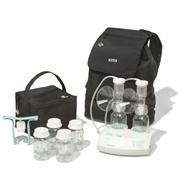Return to: Choosing a Breast Pump
Using a Breast Pump
by Susie Hamilton
Breast Pumps Direct
Product Expert

Although you may have been breastfeeding for quite some time, using a breast pump will be a completely different experience. We’ve outlined a list of steps and tips to make your first pumping experience a little easier.
Before you begin pumping for the first time, familiarize yourself with the pump and all of its included parts. Be sure that you are able to assemble and disassemble it without any problems.
Then wash and sterilize all pump parts that will be exposed to milk before you use it for the first time. For more information about cleaning and sterilizing your pump read Keeping Your Breast Pump Clean.
Basic Mechanics of Pumping
When you are ready to begin pumping, place the pump’s breast shield on your breast with your nipple centered in the shield. If the shield is not centered over your nipple, your nipple will rub against the shield and the friction may cause pain and/or discomfort while pumping.
If you are using a manual pump, you can begin pumping by squeezing the pump handle. Rapid squeezes can help you to achieve let-down because they mimic the way your baby begins to nurse. Once let-down has been achieved, you can begin to use squeezes that are longer and more drawn out to effectively empty your breast. When the flow of your milk slows down you can begin to pump your other breast.
If you have an electric pump, begin your pumping session at the lowest speed and suction settings available. This will allow you to become comfortable with the pump. Once you are comfortable with the pump you can manipulate the speed and suction to stimulate let-down and milk flow as needed. If you are using a single electric pump, you can begin to pump your other breast when your milk flow slows down significantly.
After each pumping session, you should disassemble the pump and wash, rinse and dry all parts that your milk touches before using it again.
Increase the Success of Your Pumping Session
Choose or create a comforting environment – Being relaxed will help to ensure that you pump successfully. Keeping a photo of your baby or an item that smells like your baby near by can help you relax. Informing others of your pumping schedule can eliminate unnecessary interruptions and make it easier to pump successfully.
Start pumping before you need to – If you’ll need to pump when you return to work try to begin pumping at least 2 weeks before your return. This will give you time to adjust to pumping, and it will give you a chance to build up an emergency supply of milk.
Set a pumping schedule – Since your milk is produced on demand, setting a schedule and sticking to it will ensure that you are able to maintain your milk supply. If you will be pumping for all of your baby’s feedings, you will want to pump to in place of each of your baby’s feedings throughout the day.
Let gravity help you – Leaning forward while you are pumping makes it easier for your milk to flow through the breast shield and into the collection bottle. It also helps to prevent milk from backing up into the breast shield.
Give your breasts a little TLC – Using lanolin cream on the breast shields can help to reduce chafing that may occur from frequent pumping. It can also help to draw more of your breast into the shield. Applying a warm compress and gentle massage to your breast can help to increase your milk flow before pumping.
When you are ready to begin using your pump, be sure to have clean, sterilized storage containers and make sure that you know how to properly store your expressed milk. The article Breast Milk Storage Guidelines provides plenty of information on how long your milk can be stored.
Return to: Choosing a Breast Pump



